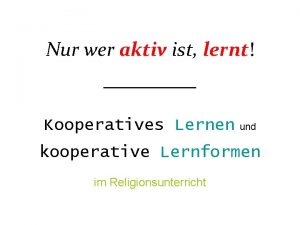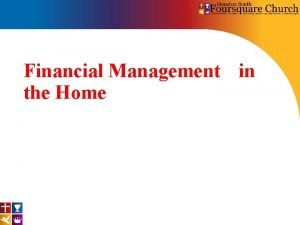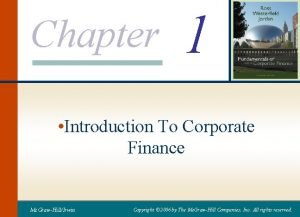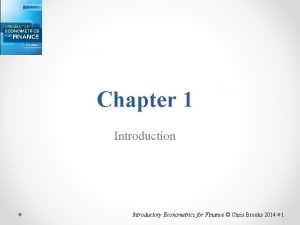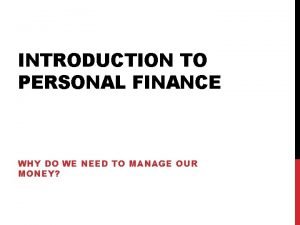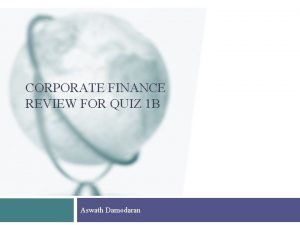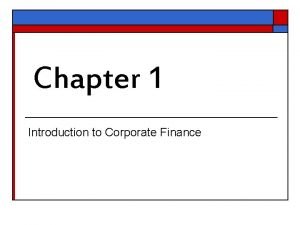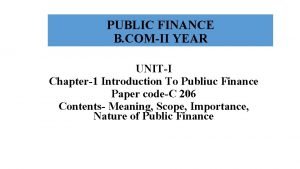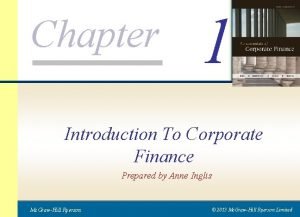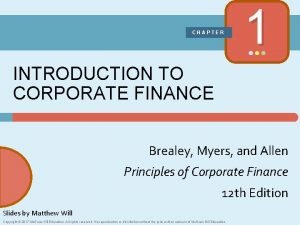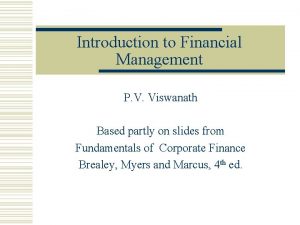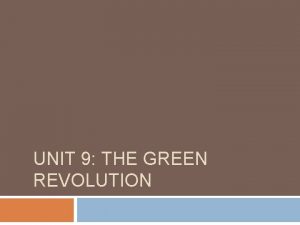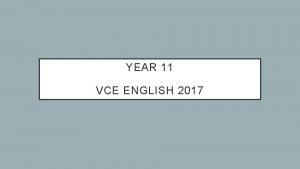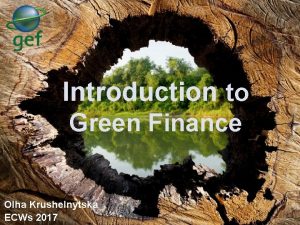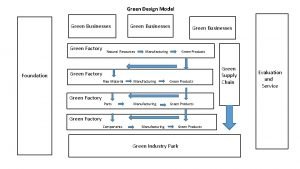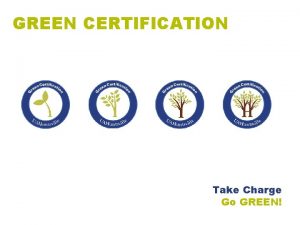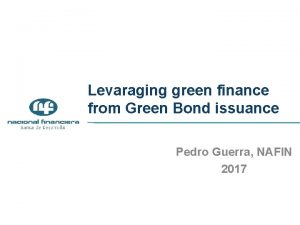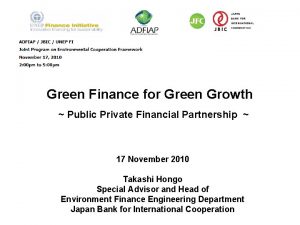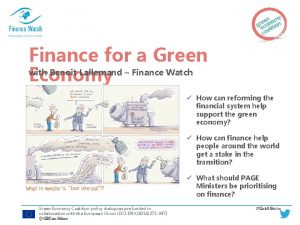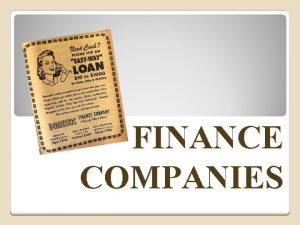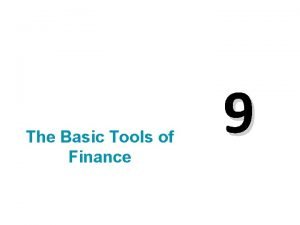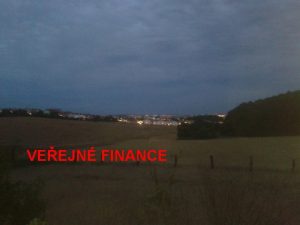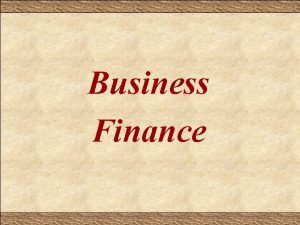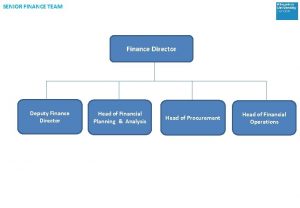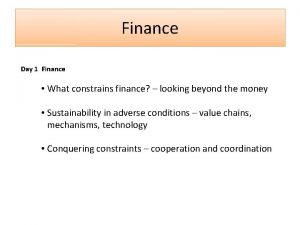Introduction to Green Finance Olha Krushelnytska ECWs 2017























- Slides: 23

Introduction to Green Finance Olha Krushelnytska ECWs 2017

Need for Additional Finance Annual funding needed: Conservation $400 -600 billion (spent only $50 -62 billion) $300 -$400 b gap = 1% of private sector investments Public $ can cover less than 15% Energy Access - $45 billion (spent $9 billion) Renewables - $320 billion (spent $154 billion) Efficiency - $390 billion (spent $225 billion) Additional finance (gap) - $350 billion Climate $392 invested in 2014 (>60% private$) - still falling short $0. 25 trillion

WHY this session? ü Private capital - the biggest part of conservation/climate funding ü To access private finance, we need to know how it works. Finance can be explained in simple terms ü We can apply this knowledge to answer the following: • How do we develop socially beneficial projects which attract private finance? • How do we make the project sustainable long term (after the funding is over)? • How do we prioritize our work program to attract more capital?

Overview • Main financial instruments in conservation • Debt / Equity / Guarantees • Leveraging private sector capital • Cases • • • Forestry fund Fisheries fund Energy efficiency program Audience: professionals entering Green Finance space

Green Finance: Definition Use of financial products and services, such as loans, insurance, stocks, private equity & bonds in green (or eco-friendly) projects Green finance is more than climate finance, but includes land, forests, water, oceans, conservation, resilience--indeed every type of GEF investment

Green Finance: Brief History Investment in conservation evolved: 19 th century: simple public sector financing (taxes, fees, stamps and government spending) 20 th century: mix of public & philanthropic finance Last 25 years: growing involvement of the private sector + the development of new financial mechanisms E. g. we can use tropical forest assets to generate revenues from operations in fields of sustainable timber, agriculture and ecotourism Financial innovations: social policy bonds, crowdsourcing initiatives (online platforms to mobilize capital) – will transform raising capital

Green Finance: Asset Classes Asset class - group of financial instruments that exhibits similar characteristics, behaves similarly in the marketplace and is subject to the same laws and regulations Main asset classes / financial instruments in green finance: (1) Equity (=Stocks) (2) Debt (= Fixed Income) Guarantees (risk management tool) also widely used in conservation

Equity Financing Equity - ownership in the business Common shares (junior equity) vs Preferred shares - Junior shares are subordinated to preferred shares - Liquidation: preferred stockholders paid first - Dividends: different/greater for preferred shares Public institutions often invest in junior equity absorbs risks Private investors invest preferred shares (senior shares) Private Investors, DFIs, IFIs Senior/Preferred Shares, Senior Debt Public Donors, GEF Junior Shares, Grants

Equity in GEF projects GEF: supporting small scale clean energy projects GEF invested $4. 5 m in junior equity of Africa Renewable Energy Fund (AREF): • bought common shares with return capped at 4% • Fund invests in clean energy companies/projects • Fund is managed by the African Development Bank (Af. DB) • Af. DB and other donors provided additional $25 million Result: • By accepting a capped return, the GEF enables net returns to other investors to increase by 2 -3% • which will expand the range of potentially investable projects and reduce the need for enhanced policy incentives to make projects bankable • expected to attract at least $150 million in co-financing

Debt Financing Notes, bonds, loans, debentures, certificates, mortgages, leases & other agreements Loan: $ from a bank to a company, with interest payment, over specific time • collateral to guarantee repayment (if difficult equity preferred) Bond: $ from the public market to a company • trade on public market and involve larger amounts (typically min $100 m) Seniority • Senior debt: greater security (lower risk) & lower interest payment • Debt is senior to Equity - creditors are paid before shareholders Private Investors Senior Debt (Senior Notes, Loans) Public Donors, GEF Subordinated Debt (Subordinated Notes, Loans)

Debt in GEF projects GEF provided subordinated debt for energy efficient transport • The Green Logistics Program, managed by EBRD • GEF provided $16. 4 million in subordinated debt (junior funding) in projects, together with EBRD investments • EBRD will invest its own funds in projects that otherwise would be priced excessively (high interest rate) • To improve efficiency of freight transport in the Black Sea Region • To promote energy eff. and lower GHG emissions in the logistics • Co-financing: $155 million during the project period, and to rise to $250 million after the project is completed • Estimated GHG emissions reductions are 9. 1 million tons CO 2 e

Guarantees Reduce the probability of default Support the flow of private investments - in projects where investors and lenders are seeking to mitigate risk • Credit guarantee – covers non payment by private borrowers. Full or partial guarantee. Partial guarantee – up to a predetermined amount • Performance guarantee - agreement between a client and a contractor for the contractor to perform all of their obligations under the contract

Guarantees in GEF projects Risk Mitigation Instrument for Land Restoration project (Latin America) Inter-American Development Bank GEF investment of $15 million, $120 million in co-financing Private sector is increasingly looking into restoration of degraded lands This requires investments that have longer payback periods & represent various types of high financial risk making them difficult to finance • GEF funds will be used to provide guarantees and subordinated loans, helping catalyze additional public and private sector investments by reducing risk • Activities: landscape regeneration; intercropping; shade-grown systems for coffee and cocoa; timber and non-timber product; improving soil, water and temperature regulation by improving agricultural land management • Benefits: restoration min 45, 000 ha, emissions reductions 4. 5 m t. CO 2 e • •

Example of Layered Capital Structure Source of Capital Structure No. 1 Structure No. 2 Private Investors Debt (Notes) Senior Debt (Senior Notes, Loans) DFIs, IFIs Senior Shares Subordinated Debt (Subordinated Notes, Loans) DFIs, IFIs Mezzanine Shares (Hybrid of Debt & Equity) Senior Shares Public Donors Junior Shares Guarantee Grant, Junior Equity, Guarantees & Subordinated Debt = Catalytic first-loss capital: • Catalytic can attract far greater capital than public or philanthropy $ • First-loss absorbs risks, which encourages other investors

Barriers for private capital • High search costs - attractive risk returns, sufficient and predictable cash flows, bigger projects • Lack of track record of projects and developers • Monitoring of conservation impact • Scalability/replicability for future projects

So what’s now? ü New types of collaboration btw investors, NGOs /project developers & public entities ü Blending of non-concessionary and concessionary capital ü Addressing the barriers within the GEF framework: • How do we develop socially beneficial projects which attract private finance? • How do we make the project sustainable long term (after the funding is over)? • How do we prioritize our work program to attract more capital

Case 1: Forestry Fund Investors (GEF and others) Forestry Fund Forestry projects/businesses The Fund will provide long-term _____ (debt, equity) funding to 5 -6 existing projects to scale them up, so they can further attract _____ (debt, equity) financing from financial institutions Other private sector reluctant to invest due to: long payback periods, lack of track record and uncertainty over product prices The GEF has taken a ______ (lower return/higher risk, higher return/lower risk) position in the fund, which helps lower risks for private sector investors The interests of _____ (debt, equity) investors are closely aligned with those of the other shareholders. Investors are incentivized to add value to such businesses by ensuring effective governance, high environmental, social and governance standards and well developed strategies

Case 1: Forestry Fund ANSWERS Investors (GEF and others) Forestry Fund Forestry projects/businesses The Fund will provide long-term equity funding to 5 -6 existing projects to scale them up, so they can further attract debt financing from financial institutions Other private sector reluctant to invest due to: long payback periods, lack of track record and uncertainty over product prices The GEF has taken a lower return/higher risk position in the fund, which helps lower risks for private sector investors The interests of equity investors are closely aligned with those of the other shareholders. Investors are incentivized to add value to such businesses by ensuring effective governance, high environmental, social and governance standards and well developed strategies

Case 2: Fisheries Fund Will provide long-term ______ (debt, equity, or debt and equity) investments to promising enterprises operating in the sustainable wildcaught seafood and mariculture sectors. Significant portion of capital to be used for the acquisition of fixed assets. GEF invests in _____ (stocks, loans) of 5 -7 years and expects to earn 10 -15% return. The Fund will be one of the very few financial institution providing long term financing in community fisheries.

Case 2: Fisheries Fund ANSWERS Will provide long-term debt and equity investments to promising enterprises operating in the sustainable wild-caught seafood and mariculture sectors. Significant portion of capital to be used for the acquisition of fixed assets. GEF invests in loans of 5 -7 years and expects to earn 10 -15% return. The Fund will be one of the very few financial institution providing long term financing in community fisheries.

Case 3: Energy Efficiency Program Energy Service Companies (ESCOs) - private enterprises that implement improvements to reduce energy consumptions. Require lending for equipment and process improvements. However they lack access to ____ (commercial credit, capital markets). The banks conventionally lend against high levels of _______ (fixed asset collateral or guarantees from other financial institutions). ESCOs often cannot meet these requirements. GEF funds will be used to create a______________ (performance risk guarantee, credit enhancement guarantee) program. The program includes creation of the Risk Facility. The project objective is to develop energy efficiency industry in Country A, through ______ (risk sharing, co-investing) with commercial lenders. The Risk Facility (risk sharing fund) will be used to share the risk with commercial banks. The risk sharing fund would be paid out to participating banks in the event of a loss or default - partial coverage of banks risk exposure. Thereby ESCOs can obtain a bank debt with a ______(lower, higher) cost and a______(shorter, longer) term. Banks Risk Facility Final 10% Loss: Banks Next 80% Loss: Shared equally between Risk Facility and banks First 10% Loss: Risk Facility

Case 3: Energy Efficiency ANSWERS Energy Service Companies (ESCOs) - private enterprises that implement improvements to reduce energy consumptions. Require lending for equipment and process improvements. However they lack access to commercial credit. The banks conventionally lend against high levels of fixed asset collateral. ESCOs often cannot meet these requirements. GEF funds will be used to create a credit enhancement guarantee program. The program includes creation of the Risk Facility. The project objective is to develop energy efficiency industry in Country A, through risk sharing with commercial lenders. The Risk Facility (risk sharing fund) will be used to share the risk with commercial banks. The risk sharing fund would be paid out to participating banks in the event of a loss or default - partial coverage of banks risk exposure. Thereby ESCOs can obtain a bank debt with a lower cost and a longer term. Banks Risk Facility Final 10% Loss: Banks Next 80% Loss: Shared equally between Risk Facility and banks First 10% Loss: Risk Facility

Thank you for your feedback! Olha Krushelnytska | okrushelnytska@thegef. org
 Olha krushelnytska
Olha krushelnytska Olha o teu
Olha o teu Green green green red
Green green green red Lernpyramide von green & green (2005)
Lernpyramide von green & green (2005) Green yellow blue red
Green yellow blue red Frc driver station mac
Frc driver station mac Financial problem introduction
Financial problem introduction Introduction to corporate finance
Introduction to corporate finance Introduction to econometrics for finance
Introduction to econometrics for finance Introduction to personal finance
Introduction to personal finance Personal finance chapter 1 review answers
Personal finance chapter 1 review answers Damodaran beta
Damodaran beta Corporate finance chapter 1
Corporate finance chapter 1 Comii
Comii Chapter 1 introduction to corporate finance
Chapter 1 introduction to corporate finance Chapter 1 introduction to corporate finance
Chapter 1 introduction to corporate finance Local government finance
Local government finance P.v. viswanath
P.v. viswanath Objective of green revolution
Objective of green revolution Introduction of green revolution
Introduction of green revolution Introduction of green revolution
Introduction of green revolution Essay structure
Essay structure Vcaa english exam 2017
Vcaa english exam 2017 Xxxxxx 2016
Xxxxxx 2016



